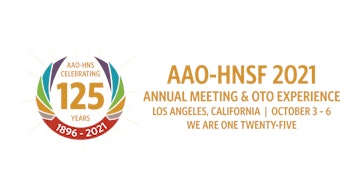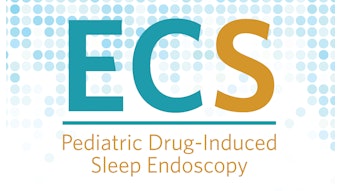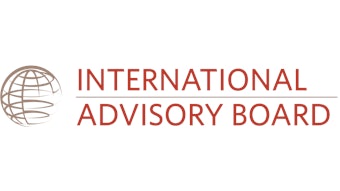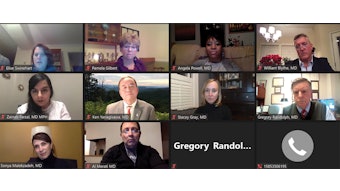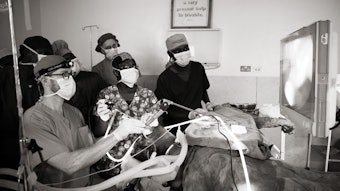Out of Committee: Sleep Disorders | Update on the Management of Mild OSA in Children
Pediatric obstructive sleep apnea (OSA) is still a relatively “young” field. It was not until the late 1990s that many of the sequelae of pediatric OSA, such as poor focus and behavior problems, became increasingly recognized and reported.
Cristina Baldassari, MD, Chair of the AAO-HNS Sleep Disorders Committee

Pediatric obstructive sleep apnea (OSA) is still a relatively “young” field. It was not until the late 1990s that many of the sequelae of pediatric OSA, such as poor focus and behavior problems, became increasingly recognized and reported. In the years since, there have been significant advances in the evaluation and management of pediatric OSA. However, numerous controversies and challenges remain, including determining the best management strategy for children with mild OSA.
The optimal management of mild OSA in children is still being investigated. While adenotonsillectomy has been the traditional treatment for pediatric OSA, the recent multi-institutional, randomized Childhood Adenotonsillectomy Trial1 demonstrated that watchful waiting might also be effective. This trial compared the efficacy of watchful waiting versus adenotonsillectomy for the treatment of non-severe OSA (average apnea hypopnea index (AHI) of 4) in over 400 otherwise healthy children. While the surgery group experienced more significant improvements in PSG parameters, behavior, and quality of life (QOL), approximately 50% of children in the watchful waiting group had resolution of their OSA on seven-month follow-up PSG. Despite resolution of their OSA on PSG, however, 85% of children in the observation arm of the trial continued to experience snoring and other sleep sequelae. One of the main limitations of this study was the limited age range of subjects (five to 12 years of age), which made it difficult to draw conclusions regarding younger children among whom snoring and OSA are common.
Hot off the presses this year is the Karolinska AdenoTonsillEctomy (KATE) study2 that sought to clarify the role of adenotonsillectomy in the management of young children with non-severe (AHI > 1 and < 10) OSA. The authors randomized children two to five years of age to either adenotonsillectomy or watchful waiting, then repeated PSG and QOL assessments after six months. In children with mild disease (AHI > 1 and < 5), the surgery and watchful waiting group had similar AHI outcomes at follow-up. However, among children with moderate OSA, there was a clinically meaningful improvement in PSG parameters in the adenotonsillectomy group. Children in the adenotonsillectomy group had large improvements in QOL regardless of baseline disease severity when compared with the watchful waiting group. This study was limited by its lack of diverse sample with the majority of children being White and non-obese.
There is also a growing body of literature demonstrating the efficacy of anti-inflammatory medications, namely intranasal steroids and montelukast, in the management of mild OSA in children. Montelukast is a leukotriene modifier; research has demonstrated the presence of leukotriene receptors on the surface of adenoid and tonsil lymphoid tissue. A recent meta-analysis,3 which included several randomized, placebo-controlled trials, noted significant reduction in the AHI in children with non-severe OSA treated with montelukast. In addition, research has demonstrated improvement in QOL and symptom burden in children managed with montelukast and intranasal steroids.4 While montelukast has been used extensively to treat asthma and allergic rhinitis, the U.S. Food and Drug Administration recently warned of the mental health side effects of this medication. Montelukast should not be prescribed to children with a history of depression or behavioral problems. Prior research has also suggested that obese children, those older than seven years of age, and those with Down syndrome are less likely to respond to medical management with montelukast.5,6 A final point of controversy regarding medical management of pediatric OSA involves duration of therapy. Most children are treated with a three- to four-month course of medical therapy, but data regarding long-term outcomes are lacking.
It can be challenging for providers to counsel caregivers of children with non-severe OSA regarding the best management strategy. Certainly the literature noted above supports managing children with milder symptoms with watchful waiting or anti-inflammatory medications and considering surgery for those with more severe disease burden. Instruments that assess symptomatology and QOL such as the OSA-18 may be useful in assessing the impact of OSA on a child’s well-being and thus aid in management decisions.7 The OSA-18 is a short questionnaire that is simple to introduce into an otolaryngology practice. Children with an OSA-18 score indicating a moderate to severe impact of sleep disturbance on QOL (total score > 60), benefit from medical or surgical treatment. In upcoming years, shared decision-making tools will likely play a role in pediatric OSA management. Future studies that directly compare watchful waiting, medical therapy, and adenotonsillectomy in children with mild OSA are needed so that definitive treatment protocols can be developed.
References
1. Marucs C, Moore R, Rosen C, et al. A randomized trial of adenotonsillectomy for childhood sleep apnea. N Engl J Med. 2013;368:2366-2376.
2. Fehrm J; Nerfeldt P; Browaldh N, et al. Adenotonsillectomy versus Watchful Waiting in Young Children with Mild to Moderate Obstructive Sleep Apnea: KATE—A Randomized Controlled Trial. JAMA Otolaryngol Head Neck Surg. 2020 May 28;146(7):647-654.
3. Kuhle S, Hoffmann DU, Mitra S, Urschitz MS. Anti-inflammatory medications for obstructive sleep apnea in children. Cochrane Database Syst Rev. 2020.
4. Bluher AE, Brawley CC, Cunningham TD, Baldassari CM. Impact of montelukast and fluticasone on quality of life in mild pediatric sleep apnea. Int J Pediatr Otorhinolaryngol. 2019;125:66-70.
5. Kheirandish-Gozal L, Bhattacharjee R, Bandla H, et al. Antiinflammatory therapy outcomes for mild OSA in children. Chest. 2014;146:88-95.
6. Yu W, Sarber KM, Howard JJM, et al. Children with Down syndrome and mild OSA: treatment with medication versus observation. J Clin Sleep Med. 2020;16(6):899-906.
7. Volsky PG, Woughter M, Beydoun H, Derkay C, Baldassari CM. Adenotonsillectomy vs Observation for Management of Mild Obstructive Sleep Apnea in Children. Otolaryngol Head Neck Surg. 2014;150: 126-132.


